Cost Accounting: Traditional Budgeting and Standard Costing Analysis
VerifiedAdded on 2022/11/25
|9
|3025
|191
Essay
AI Summary
This essay delves into the realm of traditional budgeting within the context of cost accounting, analyzing its significance in the contemporary business environment. It explores the traditional budgeting system, highlighting its role in estimating income and expenses, and its common use in managing business operations. The essay discusses the advantages and disadvantages of traditional budgeting, leading to the emergence of alternative budgeting systems. It emphasizes the necessity of a well-structured budgetary system for effective planning, control, and coordination of organizational activities. The essay also examines the concepts of incremental budgeting, rolling forecast budgets, activity-based budgeting, and zero-based budgeting, comparing and contrasting their applications. It also focuses on the role of standard costing, and variance analysis. The research is based on the provided texts, exploring the relevance of traditional budgeting and standard costing in the contemporary business environment, and how it impacts decision-making, employee motivation, and overall organizational performance.
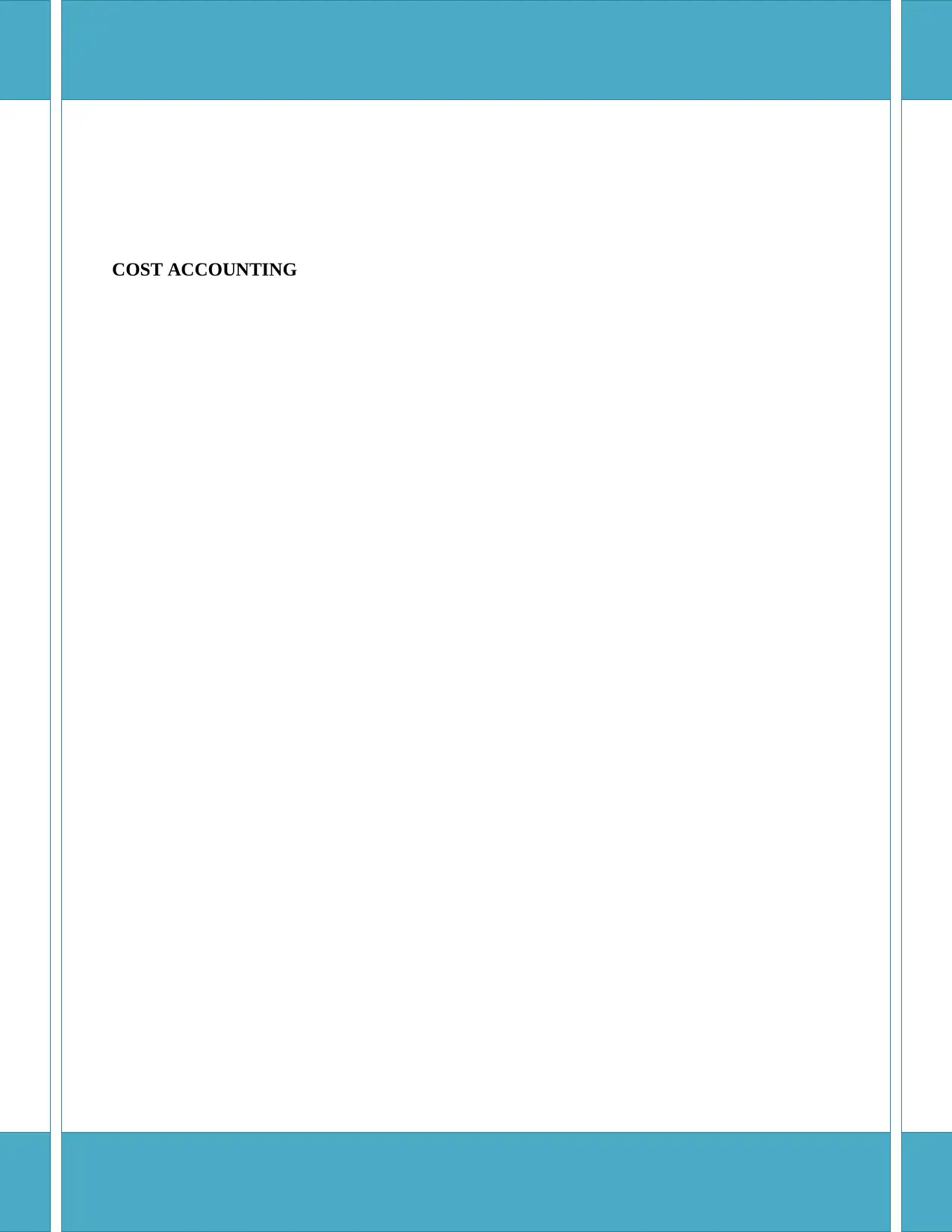
COST ACCOUNTING
Paraphrase This Document
Need a fresh take? Get an instant paraphrase of this document with our AI Paraphraser
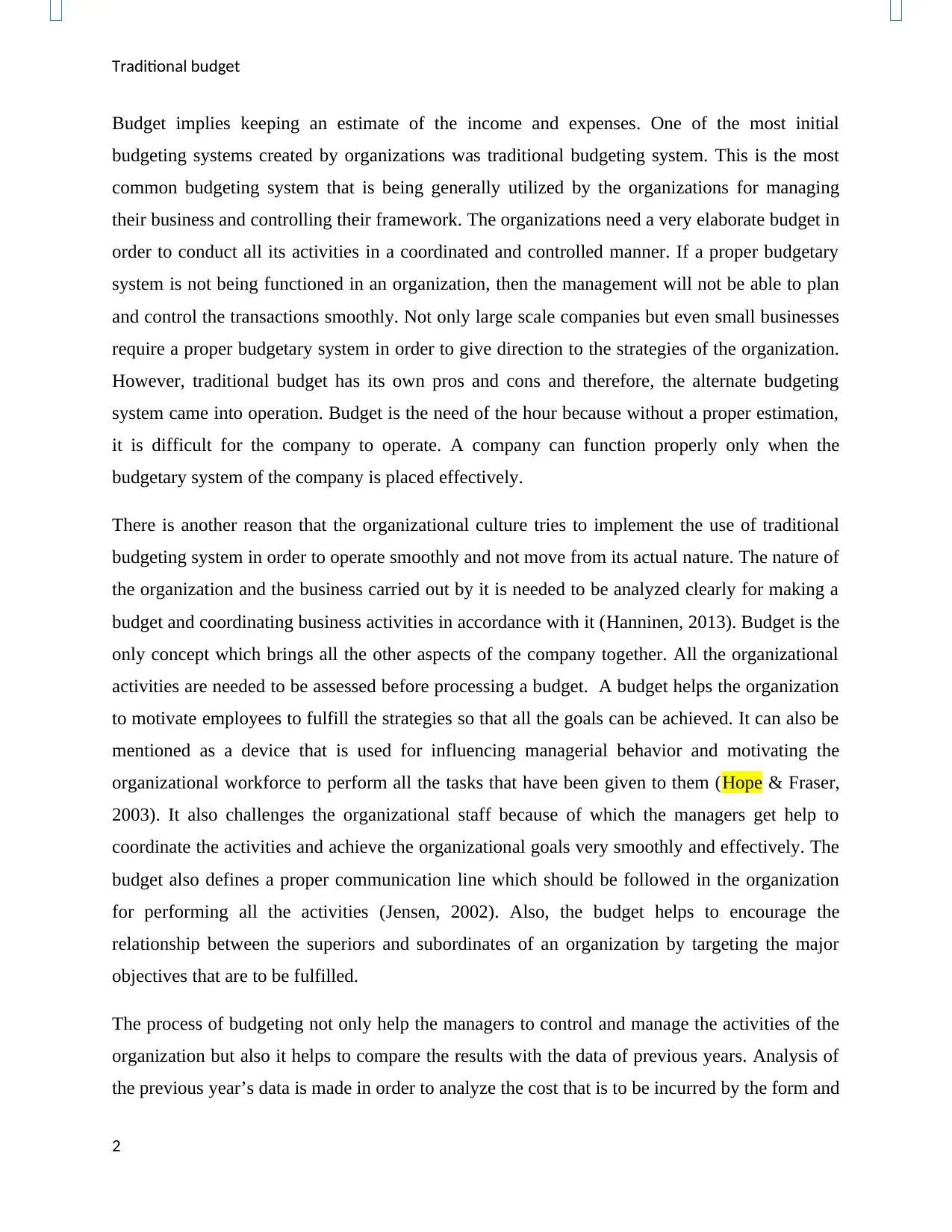
Traditional budget
Budget implies keeping an estimate of the income and expenses. One of the most initial
budgeting systems created by organizations was traditional budgeting system. This is the most
common budgeting system that is being generally utilized by the organizations for managing
their business and controlling their framework. The organizations need a very elaborate budget in
order to conduct all its activities in a coordinated and controlled manner. If a proper budgetary
system is not being functioned in an organization, then the management will not be able to plan
and control the transactions smoothly. Not only large scale companies but even small businesses
require a proper budgetary system in order to give direction to the strategies of the organization.
However, traditional budget has its own pros and cons and therefore, the alternate budgeting
system came into operation. Budget is the need of the hour because without a proper estimation,
it is difficult for the company to operate. A company can function properly only when the
budgetary system of the company is placed effectively.
There is another reason that the organizational culture tries to implement the use of traditional
budgeting system in order to operate smoothly and not move from its actual nature. The nature of
the organization and the business carried out by it is needed to be analyzed clearly for making a
budget and coordinating business activities in accordance with it (Hanninen, 2013). Budget is the
only concept which brings all the other aspects of the company together. All the organizational
activities are needed to be assessed before processing a budget. A budget helps the organization
to motivate employees to fulfill the strategies so that all the goals can be achieved. It can also be
mentioned as a device that is used for influencing managerial behavior and motivating the
organizational workforce to perform all the tasks that have been given to them (Hope & Fraser,
2003). It also challenges the organizational staff because of which the managers get help to
coordinate the activities and achieve the organizational goals very smoothly and effectively. The
budget also defines a proper communication line which should be followed in the organization
for performing all the activities (Jensen, 2002). Also, the budget helps to encourage the
relationship between the superiors and subordinates of an organization by targeting the major
objectives that are to be fulfilled.
The process of budgeting not only help the managers to control and manage the activities of the
organization but also it helps to compare the results with the data of previous years. Analysis of
the previous year’s data is made in order to analyze the cost that is to be incurred by the form and
2
Budget implies keeping an estimate of the income and expenses. One of the most initial
budgeting systems created by organizations was traditional budgeting system. This is the most
common budgeting system that is being generally utilized by the organizations for managing
their business and controlling their framework. The organizations need a very elaborate budget in
order to conduct all its activities in a coordinated and controlled manner. If a proper budgetary
system is not being functioned in an organization, then the management will not be able to plan
and control the transactions smoothly. Not only large scale companies but even small businesses
require a proper budgetary system in order to give direction to the strategies of the organization.
However, traditional budget has its own pros and cons and therefore, the alternate budgeting
system came into operation. Budget is the need of the hour because without a proper estimation,
it is difficult for the company to operate. A company can function properly only when the
budgetary system of the company is placed effectively.
There is another reason that the organizational culture tries to implement the use of traditional
budgeting system in order to operate smoothly and not move from its actual nature. The nature of
the organization and the business carried out by it is needed to be analyzed clearly for making a
budget and coordinating business activities in accordance with it (Hanninen, 2013). Budget is the
only concept which brings all the other aspects of the company together. All the organizational
activities are needed to be assessed before processing a budget. A budget helps the organization
to motivate employees to fulfill the strategies so that all the goals can be achieved. It can also be
mentioned as a device that is used for influencing managerial behavior and motivating the
organizational workforce to perform all the tasks that have been given to them (Hope & Fraser,
2003). It also challenges the organizational staff because of which the managers get help to
coordinate the activities and achieve the organizational goals very smoothly and effectively. The
budget also defines a proper communication line which should be followed in the organization
for performing all the activities (Jensen, 2002). Also, the budget helps to encourage the
relationship between the superiors and subordinates of an organization by targeting the major
objectives that are to be fulfilled.
The process of budgeting not only help the managers to control and manage the activities of the
organization but also it helps to compare the results with the data of previous years. Analysis of
the previous year’s data is made in order to analyze the cost that is to be incurred by the form and
2
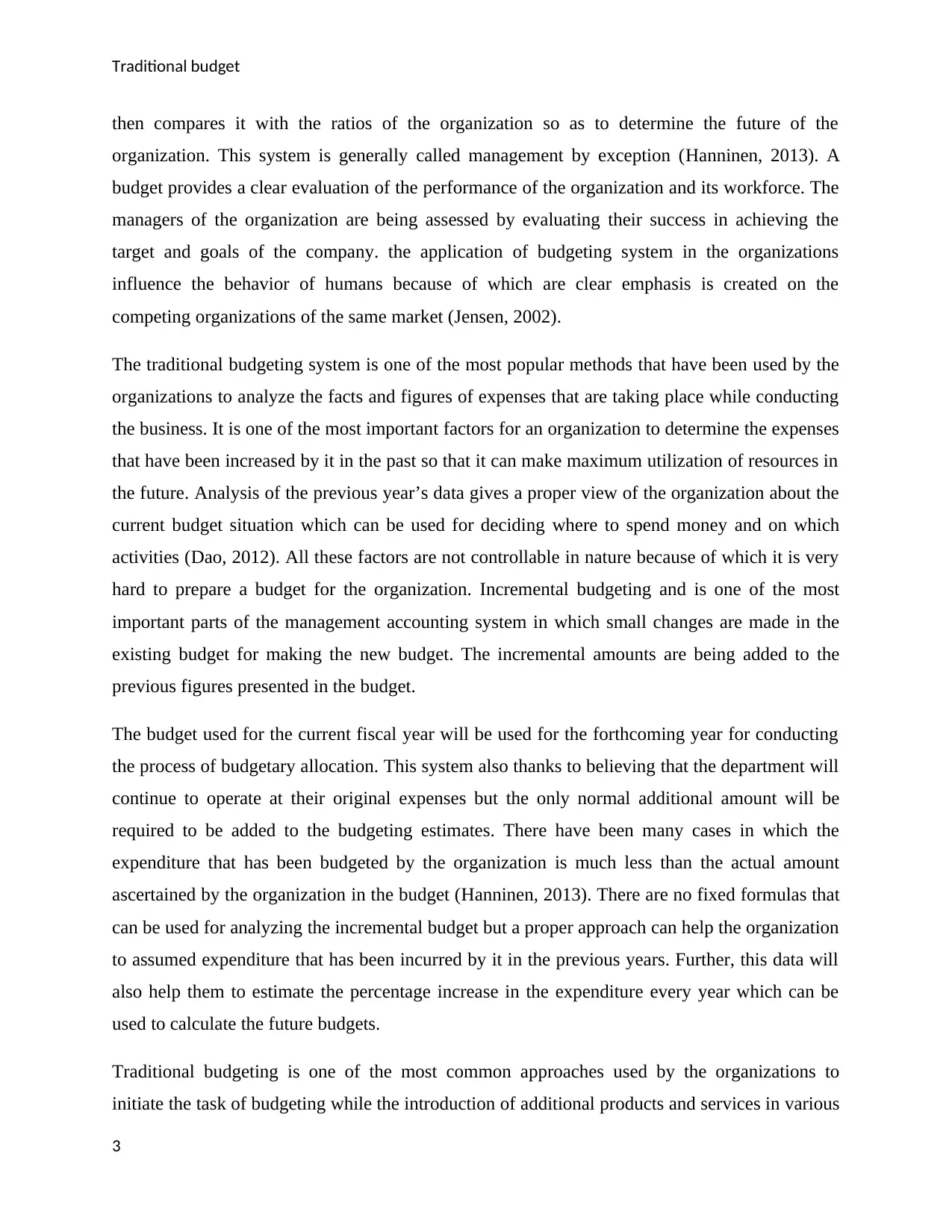
Traditional budget
then compares it with the ratios of the organization so as to determine the future of the
organization. This system is generally called management by exception (Hanninen, 2013). A
budget provides a clear evaluation of the performance of the organization and its workforce. The
managers of the organization are being assessed by evaluating their success in achieving the
target and goals of the company. the application of budgeting system in the organizations
influence the behavior of humans because of which are clear emphasis is created on the
competing organizations of the same market (Jensen, 2002).
The traditional budgeting system is one of the most popular methods that have been used by the
organizations to analyze the facts and figures of expenses that are taking place while conducting
the business. It is one of the most important factors for an organization to determine the expenses
that have been increased by it in the past so that it can make maximum utilization of resources in
the future. Analysis of the previous year’s data gives a proper view of the organization about the
current budget situation which can be used for deciding where to spend money and on which
activities (Dao, 2012). All these factors are not controllable in nature because of which it is very
hard to prepare a budget for the organization. Incremental budgeting and is one of the most
important parts of the management accounting system in which small changes are made in the
existing budget for making the new budget. The incremental amounts are being added to the
previous figures presented in the budget.
The budget used for the current fiscal year will be used for the forthcoming year for conducting
the process of budgetary allocation. This system also thanks to believing that the department will
continue to operate at their original expenses but the only normal additional amount will be
required to be added to the budgeting estimates. There have been many cases in which the
expenditure that has been budgeted by the organization is much less than the actual amount
ascertained by the organization in the budget (Hanninen, 2013). There are no fixed formulas that
can be used for analyzing the incremental budget but a proper approach can help the organization
to assumed expenditure that has been incurred by it in the previous years. Further, this data will
also help them to estimate the percentage increase in the expenditure every year which can be
used to calculate the future budgets.
Traditional budgeting is one of the most common approaches used by the organizations to
initiate the task of budgeting while the introduction of additional products and services in various
3
then compares it with the ratios of the organization so as to determine the future of the
organization. This system is generally called management by exception (Hanninen, 2013). A
budget provides a clear evaluation of the performance of the organization and its workforce. The
managers of the organization are being assessed by evaluating their success in achieving the
target and goals of the company. the application of budgeting system in the organizations
influence the behavior of humans because of which are clear emphasis is created on the
competing organizations of the same market (Jensen, 2002).
The traditional budgeting system is one of the most popular methods that have been used by the
organizations to analyze the facts and figures of expenses that are taking place while conducting
the business. It is one of the most important factors for an organization to determine the expenses
that have been increased by it in the past so that it can make maximum utilization of resources in
the future. Analysis of the previous year’s data gives a proper view of the organization about the
current budget situation which can be used for deciding where to spend money and on which
activities (Dao, 2012). All these factors are not controllable in nature because of which it is very
hard to prepare a budget for the organization. Incremental budgeting and is one of the most
important parts of the management accounting system in which small changes are made in the
existing budget for making the new budget. The incremental amounts are being added to the
previous figures presented in the budget.
The budget used for the current fiscal year will be used for the forthcoming year for conducting
the process of budgetary allocation. This system also thanks to believing that the department will
continue to operate at their original expenses but the only normal additional amount will be
required to be added to the budgeting estimates. There have been many cases in which the
expenditure that has been budgeted by the organization is much less than the actual amount
ascertained by the organization in the budget (Hanninen, 2013). There are no fixed formulas that
can be used for analyzing the incremental budget but a proper approach can help the organization
to assumed expenditure that has been incurred by it in the previous years. Further, this data will
also help them to estimate the percentage increase in the expenditure every year which can be
used to calculate the future budgets.
Traditional budgeting is one of the most common approaches used by the organizations to
initiate the task of budgeting while the introduction of additional products and services in various
3
⊘ This is a preview!⊘
Do you want full access?
Subscribe today to unlock all pages.

Trusted by 1+ million students worldwide
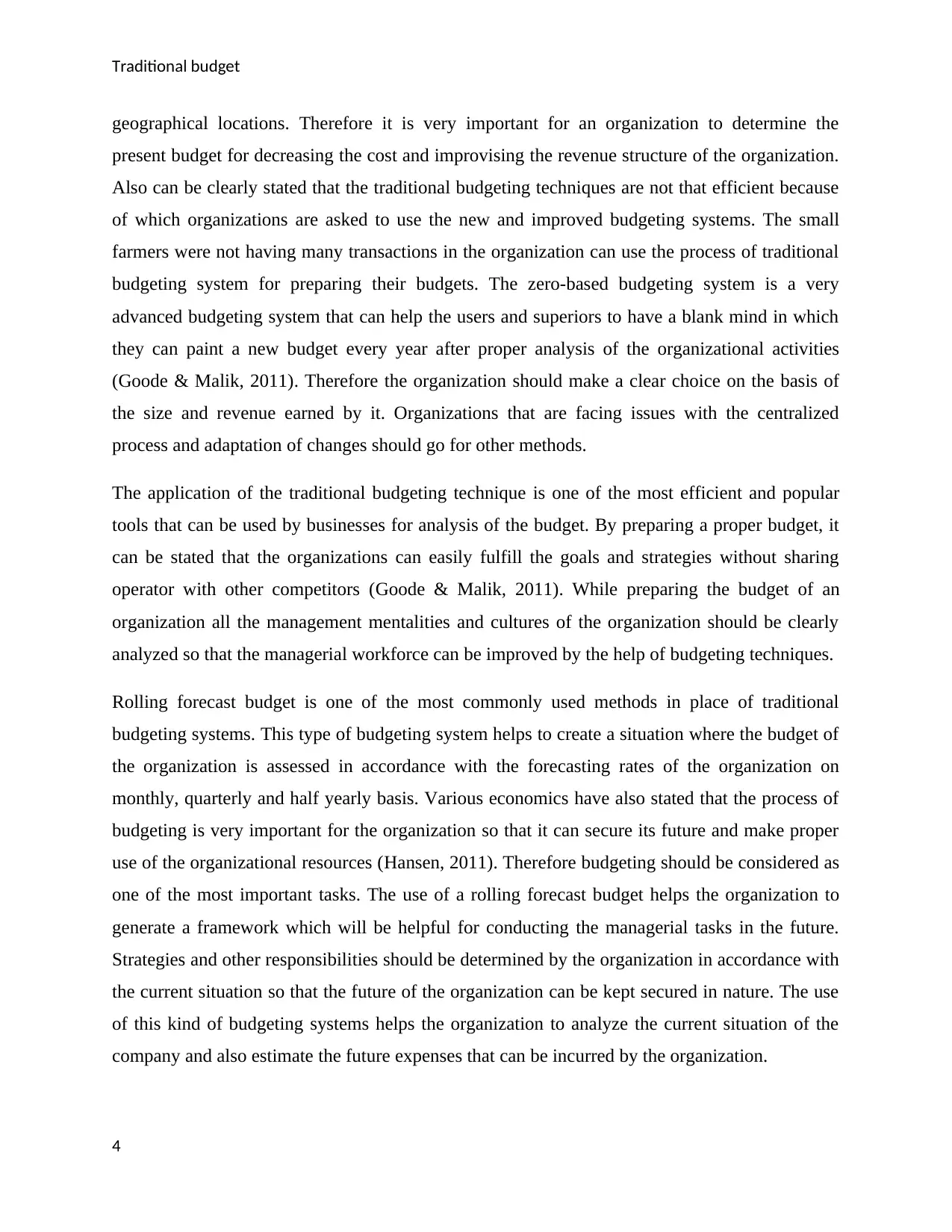
Traditional budget
geographical locations. Therefore it is very important for an organization to determine the
present budget for decreasing the cost and improvising the revenue structure of the organization.
Also can be clearly stated that the traditional budgeting techniques are not that efficient because
of which organizations are asked to use the new and improved budgeting systems. The small
farmers were not having many transactions in the organization can use the process of traditional
budgeting system for preparing their budgets. The zero-based budgeting system is a very
advanced budgeting system that can help the users and superiors to have a blank mind in which
they can paint a new budget every year after proper analysis of the organizational activities
(Goode & Malik, 2011). Therefore the organization should make a clear choice on the basis of
the size and revenue earned by it. Organizations that are facing issues with the centralized
process and adaptation of changes should go for other methods.
The application of the traditional budgeting technique is one of the most efficient and popular
tools that can be used by businesses for analysis of the budget. By preparing a proper budget, it
can be stated that the organizations can easily fulfill the goals and strategies without sharing
operator with other competitors (Goode & Malik, 2011). While preparing the budget of an
organization all the management mentalities and cultures of the organization should be clearly
analyzed so that the managerial workforce can be improved by the help of budgeting techniques.
Rolling forecast budget is one of the most commonly used methods in place of traditional
budgeting systems. This type of budgeting system helps to create a situation where the budget of
the organization is assessed in accordance with the forecasting rates of the organization on
monthly, quarterly and half yearly basis. Various economics have also stated that the process of
budgeting is very important for the organization so that it can secure its future and make proper
use of the organizational resources (Hansen, 2011). Therefore budgeting should be considered as
one of the most important tasks. The use of a rolling forecast budget helps the organization to
generate a framework which will be helpful for conducting the managerial tasks in the future.
Strategies and other responsibilities should be determined by the organization in accordance with
the current situation so that the future of the organization can be kept secured in nature. The use
of this kind of budgeting systems helps the organization to analyze the current situation of the
company and also estimate the future expenses that can be incurred by the organization.
4
geographical locations. Therefore it is very important for an organization to determine the
present budget for decreasing the cost and improvising the revenue structure of the organization.
Also can be clearly stated that the traditional budgeting techniques are not that efficient because
of which organizations are asked to use the new and improved budgeting systems. The small
farmers were not having many transactions in the organization can use the process of traditional
budgeting system for preparing their budgets. The zero-based budgeting system is a very
advanced budgeting system that can help the users and superiors to have a blank mind in which
they can paint a new budget every year after proper analysis of the organizational activities
(Goode & Malik, 2011). Therefore the organization should make a clear choice on the basis of
the size and revenue earned by it. Organizations that are facing issues with the centralized
process and adaptation of changes should go for other methods.
The application of the traditional budgeting technique is one of the most efficient and popular
tools that can be used by businesses for analysis of the budget. By preparing a proper budget, it
can be stated that the organizations can easily fulfill the goals and strategies without sharing
operator with other competitors (Goode & Malik, 2011). While preparing the budget of an
organization all the management mentalities and cultures of the organization should be clearly
analyzed so that the managerial workforce can be improved by the help of budgeting techniques.
Rolling forecast budget is one of the most commonly used methods in place of traditional
budgeting systems. This type of budgeting system helps to create a situation where the budget of
the organization is assessed in accordance with the forecasting rates of the organization on
monthly, quarterly and half yearly basis. Various economics have also stated that the process of
budgeting is very important for the organization so that it can secure its future and make proper
use of the organizational resources (Hansen, 2011). Therefore budgeting should be considered as
one of the most important tasks. The use of a rolling forecast budget helps the organization to
generate a framework which will be helpful for conducting the managerial tasks in the future.
Strategies and other responsibilities should be determined by the organization in accordance with
the current situation so that the future of the organization can be kept secured in nature. The use
of this kind of budgeting systems helps the organization to analyze the current situation of the
company and also estimate the future expenses that can be incurred by the organization.
4
Paraphrase This Document
Need a fresh take? Get an instant paraphrase of this document with our AI Paraphraser
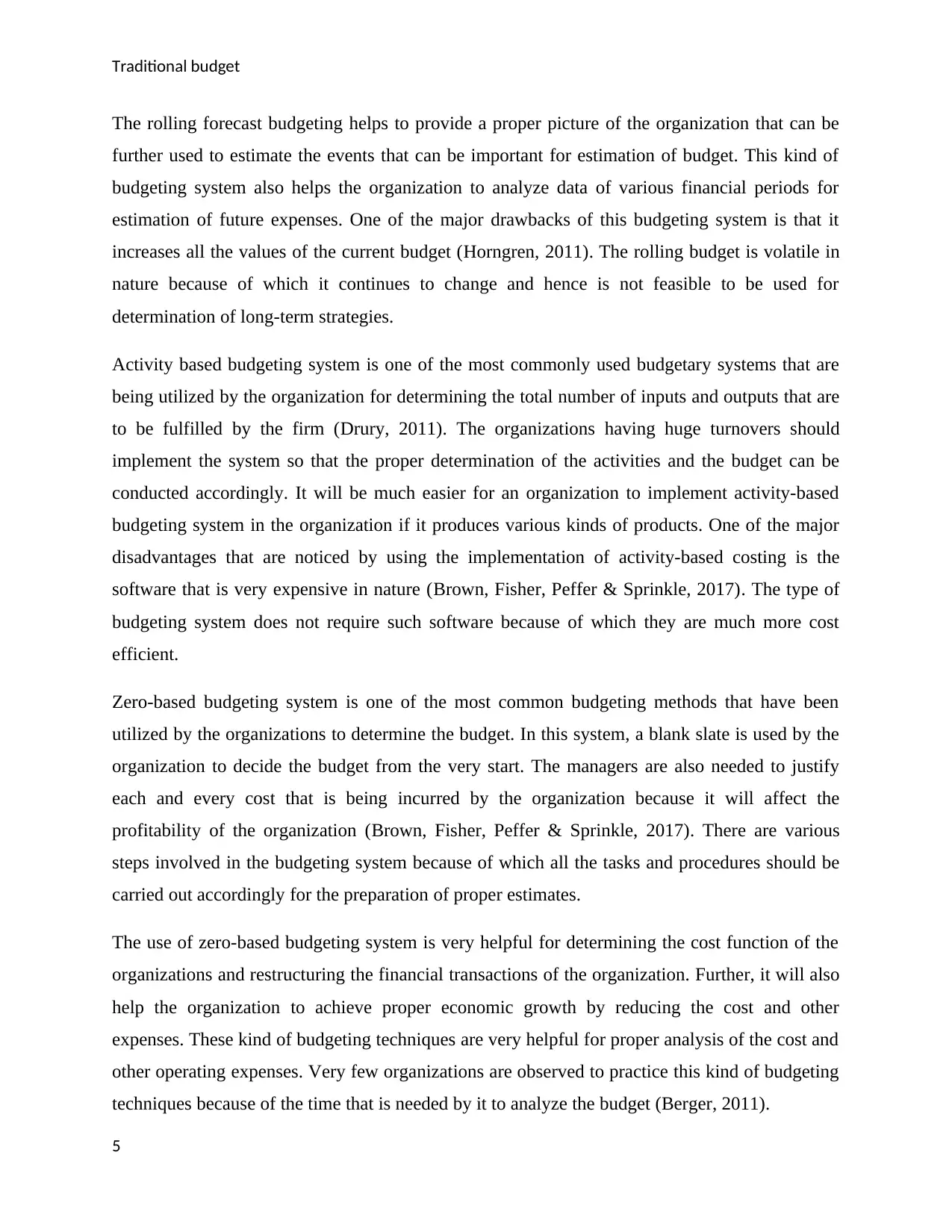
Traditional budget
The rolling forecast budgeting helps to provide a proper picture of the organization that can be
further used to estimate the events that can be important for estimation of budget. This kind of
budgeting system also helps the organization to analyze data of various financial periods for
estimation of future expenses. One of the major drawbacks of this budgeting system is that it
increases all the values of the current budget (Horngren, 2011). The rolling budget is volatile in
nature because of which it continues to change and hence is not feasible to be used for
determination of long-term strategies.
Activity based budgeting system is one of the most commonly used budgetary systems that are
being utilized by the organization for determining the total number of inputs and outputs that are
to be fulfilled by the firm (Drury, 2011). The organizations having huge turnovers should
implement the system so that the proper determination of the activities and the budget can be
conducted accordingly. It will be much easier for an organization to implement activity-based
budgeting system in the organization if it produces various kinds of products. One of the major
disadvantages that are noticed by using the implementation of activity-based costing is the
software that is very expensive in nature (Brown, Fisher, Peffer & Sprinkle, 2017). The type of
budgeting system does not require such software because of which they are much more cost
efficient.
Zero-based budgeting system is one of the most common budgeting methods that have been
utilized by the organizations to determine the budget. In this system, a blank slate is used by the
organization to decide the budget from the very start. The managers are also needed to justify
each and every cost that is being incurred by the organization because it will affect the
profitability of the organization (Brown, Fisher, Peffer & Sprinkle, 2017). There are various
steps involved in the budgeting system because of which all the tasks and procedures should be
carried out accordingly for the preparation of proper estimates.
The use of zero-based budgeting system is very helpful for determining the cost function of the
organizations and restructuring the financial transactions of the organization. Further, it will also
help the organization to achieve proper economic growth by reducing the cost and other
expenses. These kind of budgeting techniques are very helpful for proper analysis of the cost and
other operating expenses. Very few organizations are observed to practice this kind of budgeting
techniques because of the time that is needed by it to analyze the budget (Berger, 2011).
5
The rolling forecast budgeting helps to provide a proper picture of the organization that can be
further used to estimate the events that can be important for estimation of budget. This kind of
budgeting system also helps the organization to analyze data of various financial periods for
estimation of future expenses. One of the major drawbacks of this budgeting system is that it
increases all the values of the current budget (Horngren, 2011). The rolling budget is volatile in
nature because of which it continues to change and hence is not feasible to be used for
determination of long-term strategies.
Activity based budgeting system is one of the most commonly used budgetary systems that are
being utilized by the organization for determining the total number of inputs and outputs that are
to be fulfilled by the firm (Drury, 2011). The organizations having huge turnovers should
implement the system so that the proper determination of the activities and the budget can be
conducted accordingly. It will be much easier for an organization to implement activity-based
budgeting system in the organization if it produces various kinds of products. One of the major
disadvantages that are noticed by using the implementation of activity-based costing is the
software that is very expensive in nature (Brown, Fisher, Peffer & Sprinkle, 2017). The type of
budgeting system does not require such software because of which they are much more cost
efficient.
Zero-based budgeting system is one of the most common budgeting methods that have been
utilized by the organizations to determine the budget. In this system, a blank slate is used by the
organization to decide the budget from the very start. The managers are also needed to justify
each and every cost that is being incurred by the organization because it will affect the
profitability of the organization (Brown, Fisher, Peffer & Sprinkle, 2017). There are various
steps involved in the budgeting system because of which all the tasks and procedures should be
carried out accordingly for the preparation of proper estimates.
The use of zero-based budgeting system is very helpful for determining the cost function of the
organizations and restructuring the financial transactions of the organization. Further, it will also
help the organization to achieve proper economic growth by reducing the cost and other
expenses. These kind of budgeting techniques are very helpful for proper analysis of the cost and
other operating expenses. Very few organizations are observed to practice this kind of budgeting
techniques because of the time that is needed by it to analyze the budget (Berger, 2011).
5
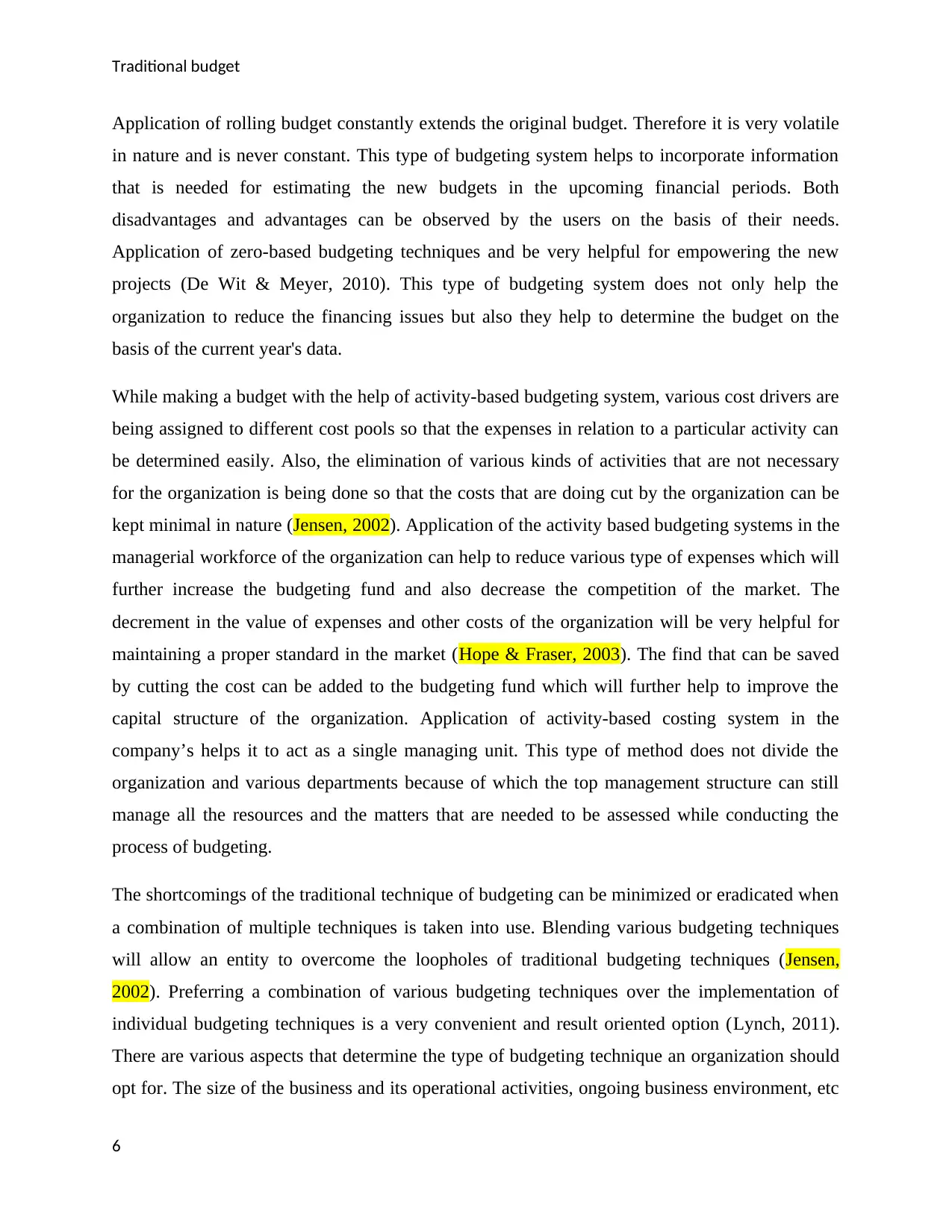
Traditional budget
Application of rolling budget constantly extends the original budget. Therefore it is very volatile
in nature and is never constant. This type of budgeting system helps to incorporate information
that is needed for estimating the new budgets in the upcoming financial periods. Both
disadvantages and advantages can be observed by the users on the basis of their needs.
Application of zero-based budgeting techniques and be very helpful for empowering the new
projects (De Wit & Meyer, 2010). This type of budgeting system does not only help the
organization to reduce the financing issues but also they help to determine the budget on the
basis of the current year's data.
While making a budget with the help of activity-based budgeting system, various cost drivers are
being assigned to different cost pools so that the expenses in relation to a particular activity can
be determined easily. Also, the elimination of various kinds of activities that are not necessary
for the organization is being done so that the costs that are doing cut by the organization can be
kept minimal in nature (Jensen, 2002). Application of the activity based budgeting systems in the
managerial workforce of the organization can help to reduce various type of expenses which will
further increase the budgeting fund and also decrease the competition of the market. The
decrement in the value of expenses and other costs of the organization will be very helpful for
maintaining a proper standard in the market (Hope & Fraser, 2003). The find that can be saved
by cutting the cost can be added to the budgeting fund which will further help to improve the
capital structure of the organization. Application of activity-based costing system in the
company’s helps it to act as a single managing unit. This type of method does not divide the
organization and various departments because of which the top management structure can still
manage all the resources and the matters that are needed to be assessed while conducting the
process of budgeting.
The shortcomings of the traditional technique of budgeting can be minimized or eradicated when
a combination of multiple techniques is taken into use. Blending various budgeting techniques
will allow an entity to overcome the loopholes of traditional budgeting techniques (Jensen,
2002). Preferring a combination of various budgeting techniques over the implementation of
individual budgeting techniques is a very convenient and result oriented option (Lynch, 2011).
There are various aspects that determine the type of budgeting technique an organization should
opt for. The size of the business and its operational activities, ongoing business environment, etc
6
Application of rolling budget constantly extends the original budget. Therefore it is very volatile
in nature and is never constant. This type of budgeting system helps to incorporate information
that is needed for estimating the new budgets in the upcoming financial periods. Both
disadvantages and advantages can be observed by the users on the basis of their needs.
Application of zero-based budgeting techniques and be very helpful for empowering the new
projects (De Wit & Meyer, 2010). This type of budgeting system does not only help the
organization to reduce the financing issues but also they help to determine the budget on the
basis of the current year's data.
While making a budget with the help of activity-based budgeting system, various cost drivers are
being assigned to different cost pools so that the expenses in relation to a particular activity can
be determined easily. Also, the elimination of various kinds of activities that are not necessary
for the organization is being done so that the costs that are doing cut by the organization can be
kept minimal in nature (Jensen, 2002). Application of the activity based budgeting systems in the
managerial workforce of the organization can help to reduce various type of expenses which will
further increase the budgeting fund and also decrease the competition of the market. The
decrement in the value of expenses and other costs of the organization will be very helpful for
maintaining a proper standard in the market (Hope & Fraser, 2003). The find that can be saved
by cutting the cost can be added to the budgeting fund which will further help to improve the
capital structure of the organization. Application of activity-based costing system in the
company’s helps it to act as a single managing unit. This type of method does not divide the
organization and various departments because of which the top management structure can still
manage all the resources and the matters that are needed to be assessed while conducting the
process of budgeting.
The shortcomings of the traditional technique of budgeting can be minimized or eradicated when
a combination of multiple techniques is taken into use. Blending various budgeting techniques
will allow an entity to overcome the loopholes of traditional budgeting techniques (Jensen,
2002). Preferring a combination of various budgeting techniques over the implementation of
individual budgeting techniques is a very convenient and result oriented option (Lynch, 2011).
There are various aspects that determine the type of budgeting technique an organization should
opt for. The size of the business and its operational activities, ongoing business environment, etc
6
⊘ This is a preview!⊘
Do you want full access?
Subscribe today to unlock all pages.

Trusted by 1+ million students worldwide
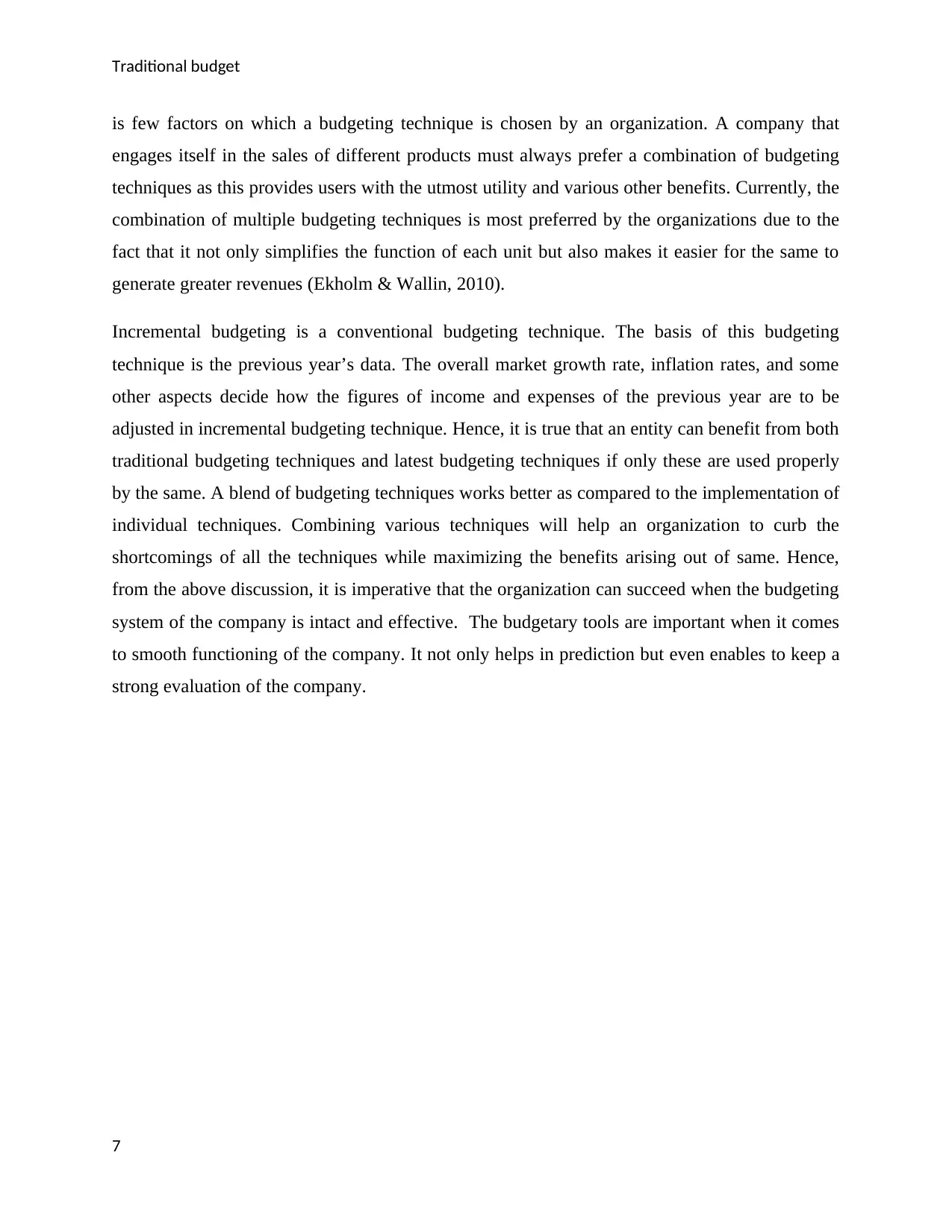
Traditional budget
is few factors on which a budgeting technique is chosen by an organization. A company that
engages itself in the sales of different products must always prefer a combination of budgeting
techniques as this provides users with the utmost utility and various other benefits. Currently, the
combination of multiple budgeting techniques is most preferred by the organizations due to the
fact that it not only simplifies the function of each unit but also makes it easier for the same to
generate greater revenues (Ekholm & Wallin, 2010).
Incremental budgeting is a conventional budgeting technique. The basis of this budgeting
technique is the previous year’s data. The overall market growth rate, inflation rates, and some
other aspects decide how the figures of income and expenses of the previous year are to be
adjusted in incremental budgeting technique. Hence, it is true that an entity can benefit from both
traditional budgeting techniques and latest budgeting techniques if only these are used properly
by the same. A blend of budgeting techniques works better as compared to the implementation of
individual techniques. Combining various techniques will help an organization to curb the
shortcomings of all the techniques while maximizing the benefits arising out of same. Hence,
from the above discussion, it is imperative that the organization can succeed when the budgeting
system of the company is intact and effective. The budgetary tools are important when it comes
to smooth functioning of the company. It not only helps in prediction but even enables to keep a
strong evaluation of the company.
7
is few factors on which a budgeting technique is chosen by an organization. A company that
engages itself in the sales of different products must always prefer a combination of budgeting
techniques as this provides users with the utmost utility and various other benefits. Currently, the
combination of multiple budgeting techniques is most preferred by the organizations due to the
fact that it not only simplifies the function of each unit but also makes it easier for the same to
generate greater revenues (Ekholm & Wallin, 2010).
Incremental budgeting is a conventional budgeting technique. The basis of this budgeting
technique is the previous year’s data. The overall market growth rate, inflation rates, and some
other aspects decide how the figures of income and expenses of the previous year are to be
adjusted in incremental budgeting technique. Hence, it is true that an entity can benefit from both
traditional budgeting techniques and latest budgeting techniques if only these are used properly
by the same. A blend of budgeting techniques works better as compared to the implementation of
individual techniques. Combining various techniques will help an organization to curb the
shortcomings of all the techniques while maximizing the benefits arising out of same. Hence,
from the above discussion, it is imperative that the organization can succeed when the budgeting
system of the company is intact and effective. The budgetary tools are important when it comes
to smooth functioning of the company. It not only helps in prediction but even enables to keep a
strong evaluation of the company.
7
Paraphrase This Document
Need a fresh take? Get an instant paraphrase of this document with our AI Paraphraser
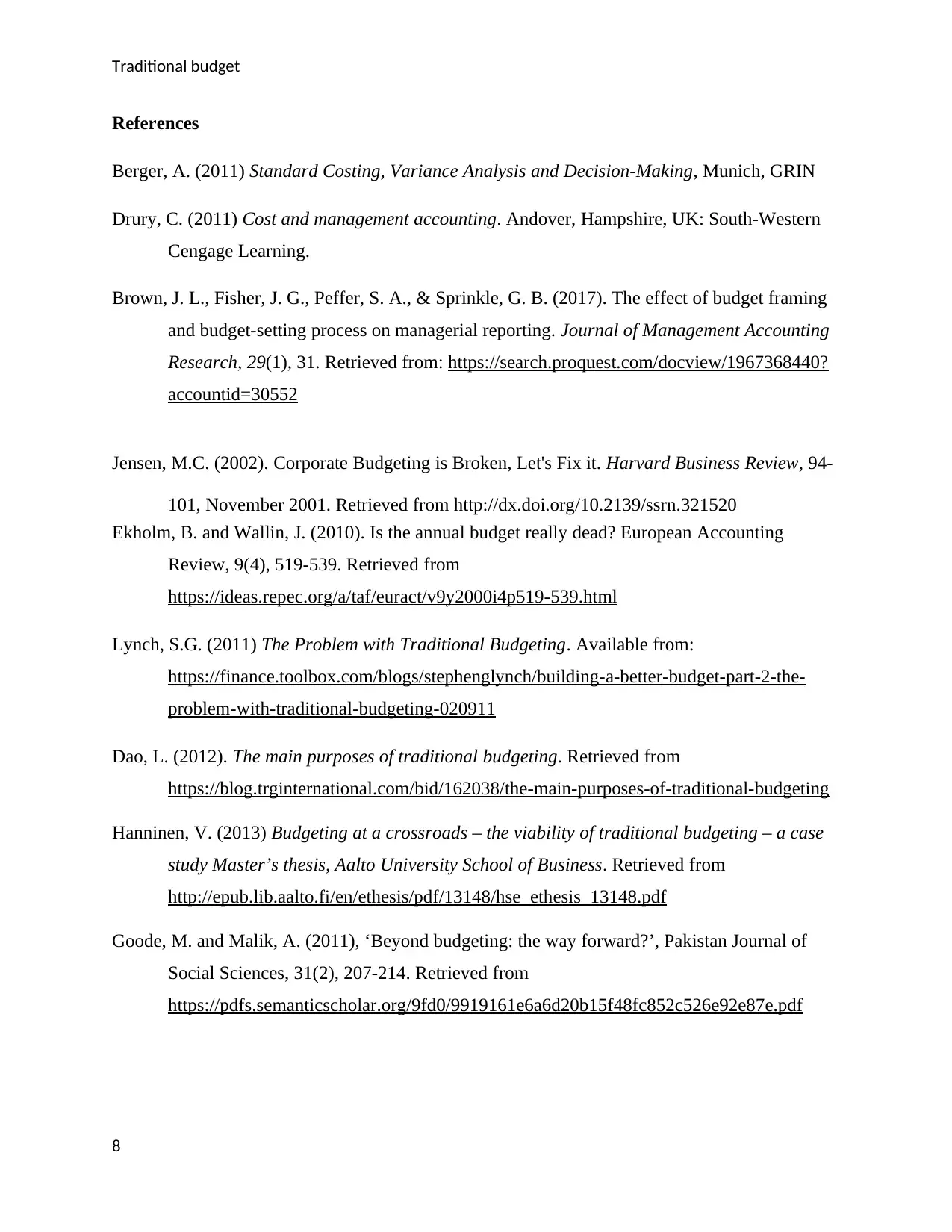
Traditional budget
References
Berger, A. (2011) Standard Costing, Variance Analysis and Decision-Making, Munich, GRIN
Drury, C. (2011) Cost and management accounting. Andover, Hampshire, UK: South-Western
Cengage Learning.
Brown, J. L., Fisher, J. G., Peffer, S. A., & Sprinkle, G. B. (2017). The effect of budget framing
and budget-setting process on managerial reporting. Journal of Management Accounting
Research, 29(1), 31. Retrieved from: https://search.proquest.com/docview/1967368440?
accountid=30552
Jensen, M.C. (2002). Corporate Budgeting is Broken, Let's Fix it. Harvard Business Review, 94-
101, November 2001. Retrieved from http://dx.doi.org/10.2139/ssrn.321520
Ekholm, B. and Wallin, J. (2010). Is the annual budget really dead? European Accounting
Review, 9(4), 519-539. Retrieved from
https://ideas.repec.org/a/taf/euract/v9y2000i4p519-539.html
Lynch, S.G. (2011) The Problem with Traditional Budgeting. Available from:
https://finance.toolbox.com/blogs/stephenglynch/building-a-better-budget-part-2-the-
problem-with-traditional-budgeting-020911
Dao, L. (2012). The main purposes of traditional budgeting. Retrieved from
https://blog.trginternational.com/bid/162038/the-main-purposes-of-traditional-budgeting
Hanninen, V. (2013) Budgeting at a crossroads – the viability of traditional budgeting – a case
study Master’s thesis, Aalto University School of Business. Retrieved from
http://epub.lib.aalto.fi/en/ethesis/pdf/13148/hse_ethesis_13148.pdf
Goode, M. and Malik, A. (2011), ‘Beyond budgeting: the way forward?’, Pakistan Journal of
Social Sciences, 31(2), 207-214. Retrieved from
https://pdfs.semanticscholar.org/9fd0/9919161e6a6d20b15f48fc852c526e92e87e.pdf
8
References
Berger, A. (2011) Standard Costing, Variance Analysis and Decision-Making, Munich, GRIN
Drury, C. (2011) Cost and management accounting. Andover, Hampshire, UK: South-Western
Cengage Learning.
Brown, J. L., Fisher, J. G., Peffer, S. A., & Sprinkle, G. B. (2017). The effect of budget framing
and budget-setting process on managerial reporting. Journal of Management Accounting
Research, 29(1), 31. Retrieved from: https://search.proquest.com/docview/1967368440?
accountid=30552
Jensen, M.C. (2002). Corporate Budgeting is Broken, Let's Fix it. Harvard Business Review, 94-
101, November 2001. Retrieved from http://dx.doi.org/10.2139/ssrn.321520
Ekholm, B. and Wallin, J. (2010). Is the annual budget really dead? European Accounting
Review, 9(4), 519-539. Retrieved from
https://ideas.repec.org/a/taf/euract/v9y2000i4p519-539.html
Lynch, S.G. (2011) The Problem with Traditional Budgeting. Available from:
https://finance.toolbox.com/blogs/stephenglynch/building-a-better-budget-part-2-the-
problem-with-traditional-budgeting-020911
Dao, L. (2012). The main purposes of traditional budgeting. Retrieved from
https://blog.trginternational.com/bid/162038/the-main-purposes-of-traditional-budgeting
Hanninen, V. (2013) Budgeting at a crossroads – the viability of traditional budgeting – a case
study Master’s thesis, Aalto University School of Business. Retrieved from
http://epub.lib.aalto.fi/en/ethesis/pdf/13148/hse_ethesis_13148.pdf
Goode, M. and Malik, A. (2011), ‘Beyond budgeting: the way forward?’, Pakistan Journal of
Social Sciences, 31(2), 207-214. Retrieved from
https://pdfs.semanticscholar.org/9fd0/9919161e6a6d20b15f48fc852c526e92e87e.pdf
8
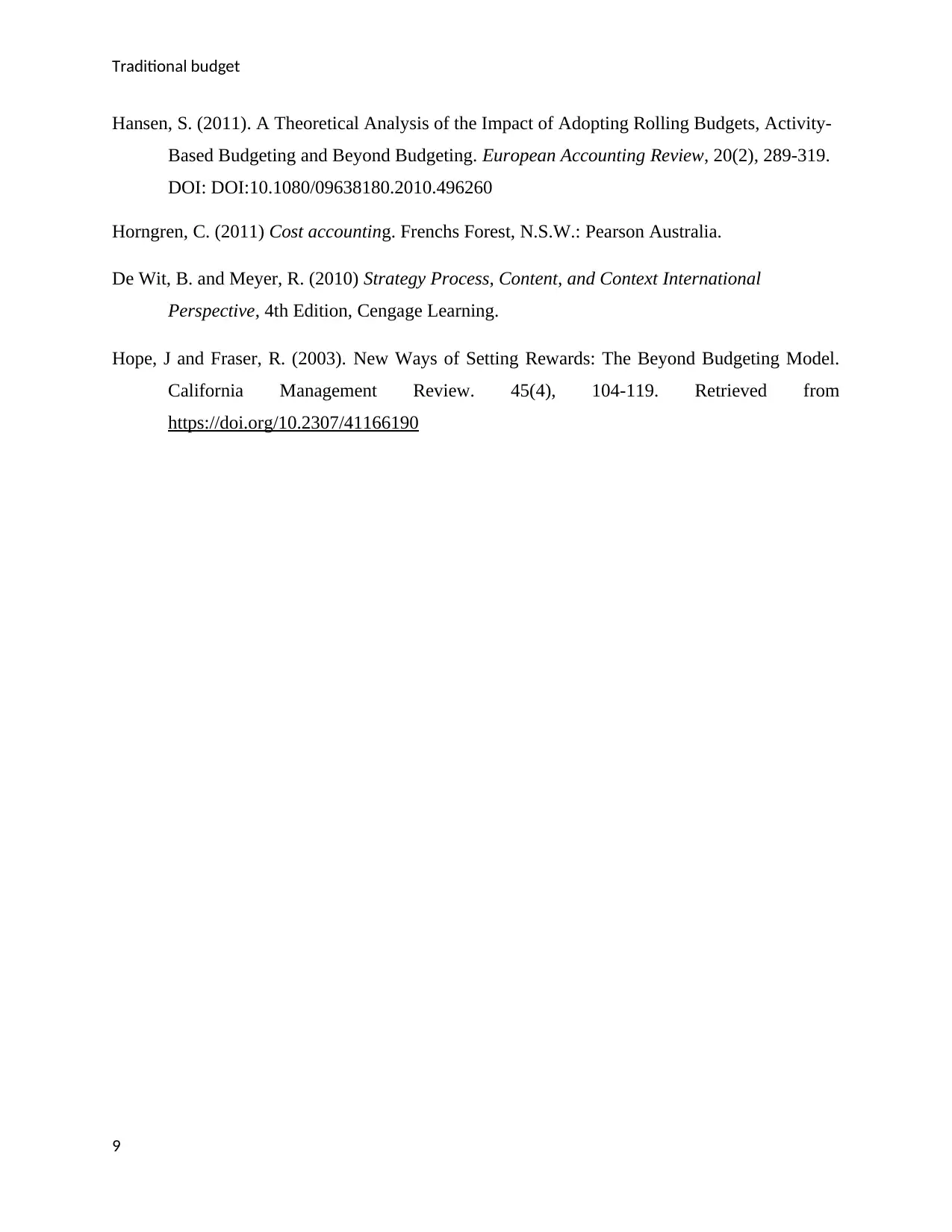
Traditional budget
Hansen, S. (2011). A Theoretical Analysis of the Impact of Adopting Rolling Budgets, Activity-
Based Budgeting and Beyond Budgeting. European Accounting Review, 20(2), 289-319.
DOI: DOI:10.1080/09638180.2010.496260
Horngren, C. (2011) Cost accounting. Frenchs Forest, N.S.W.: Pearson Australia.
De Wit, B. and Meyer, R. (2010) Strategy Process, Content, and Context International
Perspective, 4th Edition, Cengage Learning.
Hope, J and Fraser, R. (2003). New Ways of Setting Rewards: The Beyond Budgeting Model.
California Management Review. 45(4), 104-119. Retrieved from
https://doi.org/10.2307/41166190
9
Hansen, S. (2011). A Theoretical Analysis of the Impact of Adopting Rolling Budgets, Activity-
Based Budgeting and Beyond Budgeting. European Accounting Review, 20(2), 289-319.
DOI: DOI:10.1080/09638180.2010.496260
Horngren, C. (2011) Cost accounting. Frenchs Forest, N.S.W.: Pearson Australia.
De Wit, B. and Meyer, R. (2010) Strategy Process, Content, and Context International
Perspective, 4th Edition, Cengage Learning.
Hope, J and Fraser, R. (2003). New Ways of Setting Rewards: The Beyond Budgeting Model.
California Management Review. 45(4), 104-119. Retrieved from
https://doi.org/10.2307/41166190
9
⊘ This is a preview!⊘
Do you want full access?
Subscribe today to unlock all pages.

Trusted by 1+ million students worldwide
1 out of 9
Related Documents
Your All-in-One AI-Powered Toolkit for Academic Success.
+13062052269
info@desklib.com
Available 24*7 on WhatsApp / Email
![[object Object]](/_next/static/media/star-bottom.7253800d.svg)
Unlock your academic potential
Copyright © 2020–2025 A2Z Services. All Rights Reserved. Developed and managed by ZUCOL.





